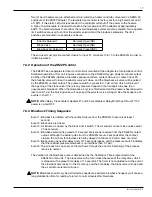
7
IM 11M12A01-01E-A
4. Installation
4.1 Installation
4.1.1 Location
The following should be taken into consideration when installing the High Temperature Adapter and
Oxygen Detector:
Easy and safe access to the adapter and detector for maintenance.
1.
Ambient temperature of not more than 150ºC (302ºF), and the detector terminal box should not be
2.
affected by radiant heat.
A clean environment without corrosive gases.
3.
CAUTION
A natural convection type detector (model ZR22G), which uses ambient air as a reference gas, requires
that the ambient air concentration be constant. Clean, dry instrument air is recommended for quality
and accurate measurement.
4. No or extremely low vibration.
5. The measurement gas satisfies the specifications described in Chapter 2 of the ZR22G Instruction
Manual, IM 11M12A01-02E.
6. No measured gas pressure fluctuations
4.1.2 Adapter Insertion Point
When preparing the insertion point, the following should be taken into consideration:
CAUTION
If the detector is mounted horizontally, the calibration and reference gas inlets on the ZR22G Probe
•
should face downwards
The sensor (Zirconia cell) at the probe tip may be damaged due to thermal shock if water drops are
•
allowed to accumulate on it, as it is always at high temperature.
When using an adapter with an eductor return, ensure that the gasket material does not interfere with the
•
eductor return port on the adapter flange.
4.1.3 Adapter Insertion and Process Flange Preparation
When forming the adapter insertion hole, the following should be taken into consideration:
Ensure that the insertion point has an equal flange type (ANSI 4.0 inch, 150# FF Flange), with proper
1.
bolt hole spacing and diameter.
The distance between the process wall and the process flange should be 100mm (4.0 inches) or
2.
more, as shown in Figure 4.1.
Attach the transport tube (if provided) to the flange base of the adapter prior to installing the ZR22P.
3.
CAUTION
The weight of the adapter and probe combined can weigh up to 100 lbs. It is recommended that
•
the ZR22P adapter be installed WITHOUT the ZR22G detector to avoid damaging the entire unit.
Use caution when lifting and positioning the adapter and probe into place. Utilize lifting devices,
•
and or a two person lift when available.
Summary of Contents for ZR22P
Page 2: ......
Page 18: ...18 IM 11M12A01 01E A Chart 7 1 Blowback Timing Sequence...
Page 22: ......
Page 23: ...23 IM 11M12A01 01E A APPENDIX A Dimensional Drawings...
Page 27: ...27 IM 11M12A01 01E A APPENDIX B Wiring Diagrams...
Page 28: ...28 IM 11M12A01 01E A...
Page 29: ...29 IM 11M12A01 01E A...
Page 30: ......







































